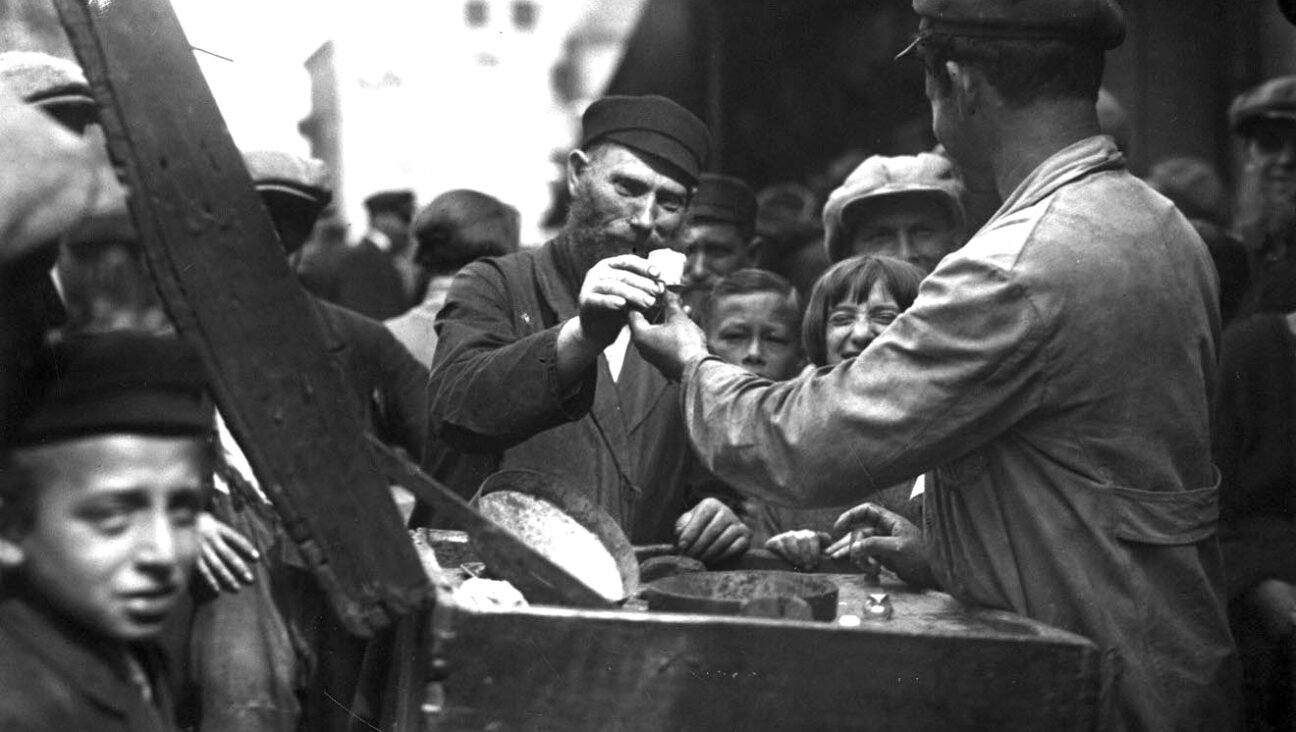A ‘Crazy’ Look at Paris Strip Palace

Graphic by Angelie Zaslavsky

Spectacle: The documentary takes the viewer inside the surprisingly engaging world of the Crazy Horse cabaret. Image by antoine poupel
Frederick Wiseman is one of the few Jewish geniuses of documentary filmmaking. In a career spanning 39 films, he has earned acclaim for portraying the internal dynamics of prisons, high schools, mental hospitals, courts, the military and zoos. In the 1995 film “Ballet,” as well as in his sumptuous 2009 movie “La Danse,” he displayed a trademark adeptness at filming bodies in motion. He returns to the subject as a featured artist in the current dance-centric Biennial of the Whitney Museum of American Art and in his most recent documentary, “Crazy Horse,” a study of bodies in a rather different motion.
It’s said that playwright Samuel Beckett used to frequent Paris’s Crazy Horse Saloon, with its nude dancers and its acute attention to what the French call les fesses (a term that evokes, by cognate, the backside’s “fissure” but has no adequate English equivalent). Beckett would sit close to the stage, at a good table, with his back — for God knows what bleak and tragicomic reason — to the show. The image has an odd resonance. Given the cabaret’s famous focus on les fesses, there may be some men, unaccustomed to displays of “T&A” with quite so much “A,” who spend the better part of the film hoping for the girls to turn around.

Frederick Wiseman Image by gretje ferguson
But who cares about men? “The key to eroticism is the woman,” Crazy Horse’s managing director, Andrée Deissenberg, says in the film, insisting that Le Crazy draws equally ardent responses from both sexes. We watch the process of selecting dancers, knowing — it’s public information — that they are chosen on the basis of rigid criteria that run counter to almost everything the word “stripper” calls to mind: Girls must be between 5 feet 4 inches and 5 feet 6 inches; nothing bigger than a B-cup; no tattoos. Indeed, the criteria might appeal to women more than to men. Elegant rather than voluptuous, the girls look like the lissome former ballerinas that many of them, in fact, are. (The first American hire, in 2008, was a former Rockette.)
Wiseman is philosophical about the spectacle. In an interview with the website Artinfo, he said that for him, “none of the dances are particularly sexual. There’s nothing at the Crazy Horse show, for example, that suggests heterosexual sex. All the acts, for whatever reason, suggest either lesbianism or masturbation. I don’t know why that is.”
The most telling scene in the film involves an audition. Crazy Horse draws dancers from all over the world (today’s company is heavy on Russians and Eastern Europeans). They are told to “be pretty, classy, relaxed, don’t stress out — and stick out your buttocks.” Each candidate gets one minute to improvise a dance, in a G-string and optional heels, to (what else?) Gnarls Barkley’s “Crazy.” One hopeful is instructed to stand in sixth position, profile. Well aware of Le Crazy’s reputation as the derrière-garde, she assumes a pose reminiscent of nothing so much as a baboon presenting its rump.
About three-quarters of the way through the film, Wiseman abandons his trademark fly-on-the-wall style and starts — perhaps for the first time in any of his films — asking his subjects direct questions. Unfortunately, the questions are directed mostly at Ali Mahdavi, the self-proclaimed Crazy Horse obsessive who, as “artistic director” (an inflated title), is slyly, if pathetically, insubordinate toward his boss, director/choreographer Philippe Decouflé.
We’d much rather hear from the individuals who actually expose themselves, the dancers; while they don’t tell their stories, we see their camaraderie and diligence, along with an endearing, unexpected wholesomeness. We watch one dancer brushing the horsehair tail that bisects her bare fesses, and several others howling around a videotape of Bolshoi bloopers. It was for strippers like these that H.L. Mencken coined the lofty term “ecdysiast.”

An exotic dancer prepares for her performance. Image by antoine poupel
Ecdysiasts or not, ballet is these dancers’ first language of instruction, and insiders will smile at the classical terminology (cambré, saut de chat, rétiré) used here to block out their bump-and-grind routines. Most viewers will be less familiar with the old burlesque techniques of strategic delay, like removing a stocking in eight counts when it really takes just four.
Unlike Darren Aronofsky, who shares Wiseman’s linked directorial interests in boxing and ballet, Wiseman films bodies in ways neither prurient nor prudish — and, of course, with none of Hollywood’s pyretic, choppy body doubling. Some of the dance numbers he films are original to Le Crazy, dating from the 1950s. In more cases, the numbers don’t show much artistic continuity with the cabaret’s old days, but they do convey something of the same saucy attitude, allowing for the passage of half a century. All are elegantly, meditatively captured by Wiseman: Three girls curling fingers and scissoring legs around a mirrored parquet; the bounce and arched backs of “Baby Buns”; the heartbreaking, brilliantly lit dancer writhing on a divan, cat-clawing the air to Antony and the Johnsons’ melancholy “Man Is the Baby.” It’s just a shame that the musical number ending the film is pure Vegas stripper kitsch, simultaneously cloying and clammy.
Neither Decouflé nor Mahdavi hesitates to invoke the word “art” on behalf of the cabaret, and when Decouflé, who studied under contemporary dance master Alwin Nikolais, performs some of the choreography himself — that is, when we see how arresting the dancing is, even on one simple, black-clad male body — we actually see what he means.
Or we think we do, until Decouflé yells for someone to bring a pair of moon boots to the girl in the revolving cage.
Margot Lurie, a former company member of ODC/Dance, is the editor of Jewish Ideas Daily. “Crazy Horse” is now in limited release.
















